Project Management: Tendering and Procurement Methods
VerifiedAdded on 2019/09/16
|23
|4798
|412
Report
AI Summary
This report provides a comprehensive analysis of tendering and procurement methods in project management, focusing on infrastructure projects. It covers the various stages of procurement, including inception, development, and implementation, and delves into the investigation of documents, procurement strategies, and standard forms of contracts. The report also examines risk management strategies, using a checklist approach to identify and mitigate potential risks. Case studies of hospital projects are included to illustrate practical applications. Furthermore, the report discusses business diversification as a means to address funding shortfalls and explores different Public-Private Partnership (PPP) methods, recommending the BOOT approach. The analysis of various project delivery models, such as construction, D&C, and managing contracts, is also provided, along with guidelines for their successful implementation. The report concludes with findings, suggestions, and recommendations for effective project delivery.
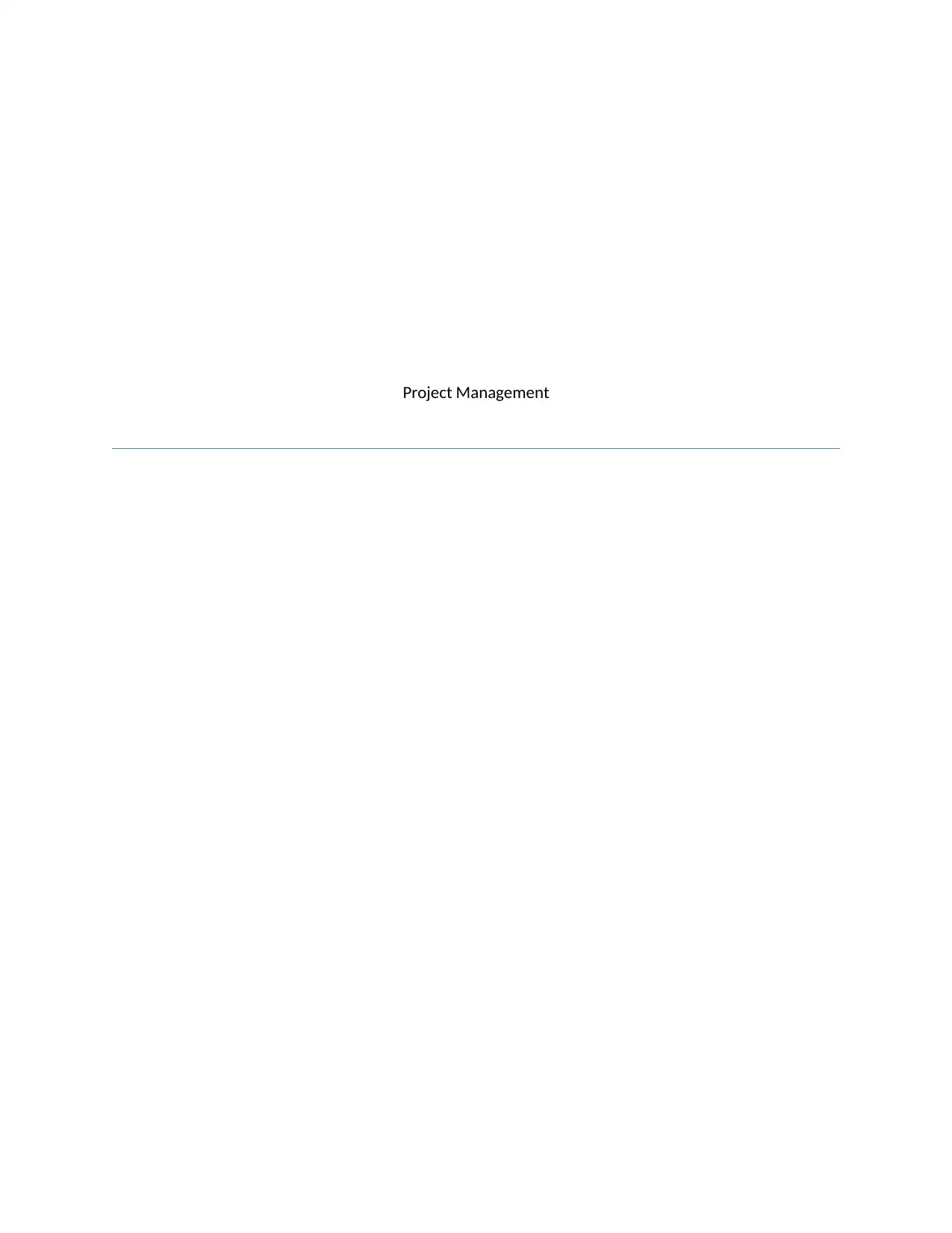
Project Management
Paraphrase This Document
Need a fresh take? Get an instant paraphrase of this document with our AI Paraphraser
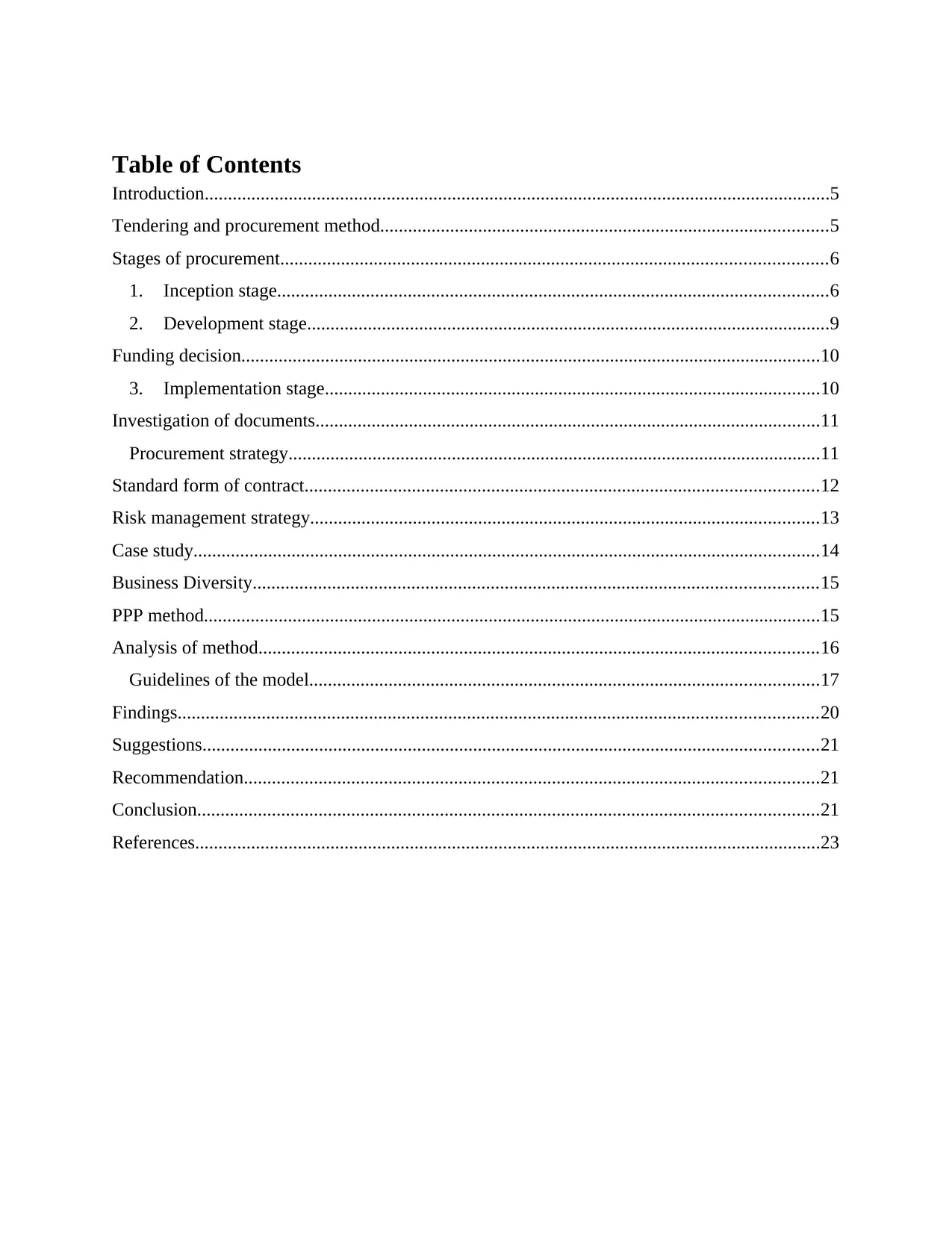
Table of Contents
Introduction......................................................................................................................................5
Tendering and procurement method................................................................................................5
Stages of procurement.....................................................................................................................6
1. Inception stage......................................................................................................................6
2. Development stage................................................................................................................9
Funding decision............................................................................................................................10
3. Implementation stage..........................................................................................................10
Investigation of documents............................................................................................................11
Procurement strategy..................................................................................................................11
Standard form of contract..............................................................................................................12
Risk management strategy.............................................................................................................13
Case study......................................................................................................................................14
Business Diversity.........................................................................................................................15
PPP method....................................................................................................................................15
Analysis of method........................................................................................................................16
Guidelines of the model.............................................................................................................17
Findings.........................................................................................................................................20
Suggestions....................................................................................................................................21
Recommendation...........................................................................................................................21
Conclusion.....................................................................................................................................21
References......................................................................................................................................23
Introduction......................................................................................................................................5
Tendering and procurement method................................................................................................5
Stages of procurement.....................................................................................................................6
1. Inception stage......................................................................................................................6
2. Development stage................................................................................................................9
Funding decision............................................................................................................................10
3. Implementation stage..........................................................................................................10
Investigation of documents............................................................................................................11
Procurement strategy..................................................................................................................11
Standard form of contract..............................................................................................................12
Risk management strategy.............................................................................................................13
Case study......................................................................................................................................14
Business Diversity.........................................................................................................................15
PPP method....................................................................................................................................15
Analysis of method........................................................................................................................16
Guidelines of the model.............................................................................................................17
Findings.........................................................................................................................................20
Suggestions....................................................................................................................................21
Recommendation...........................................................................................................................21
Conclusion.....................................................................................................................................21
References......................................................................................................................................23
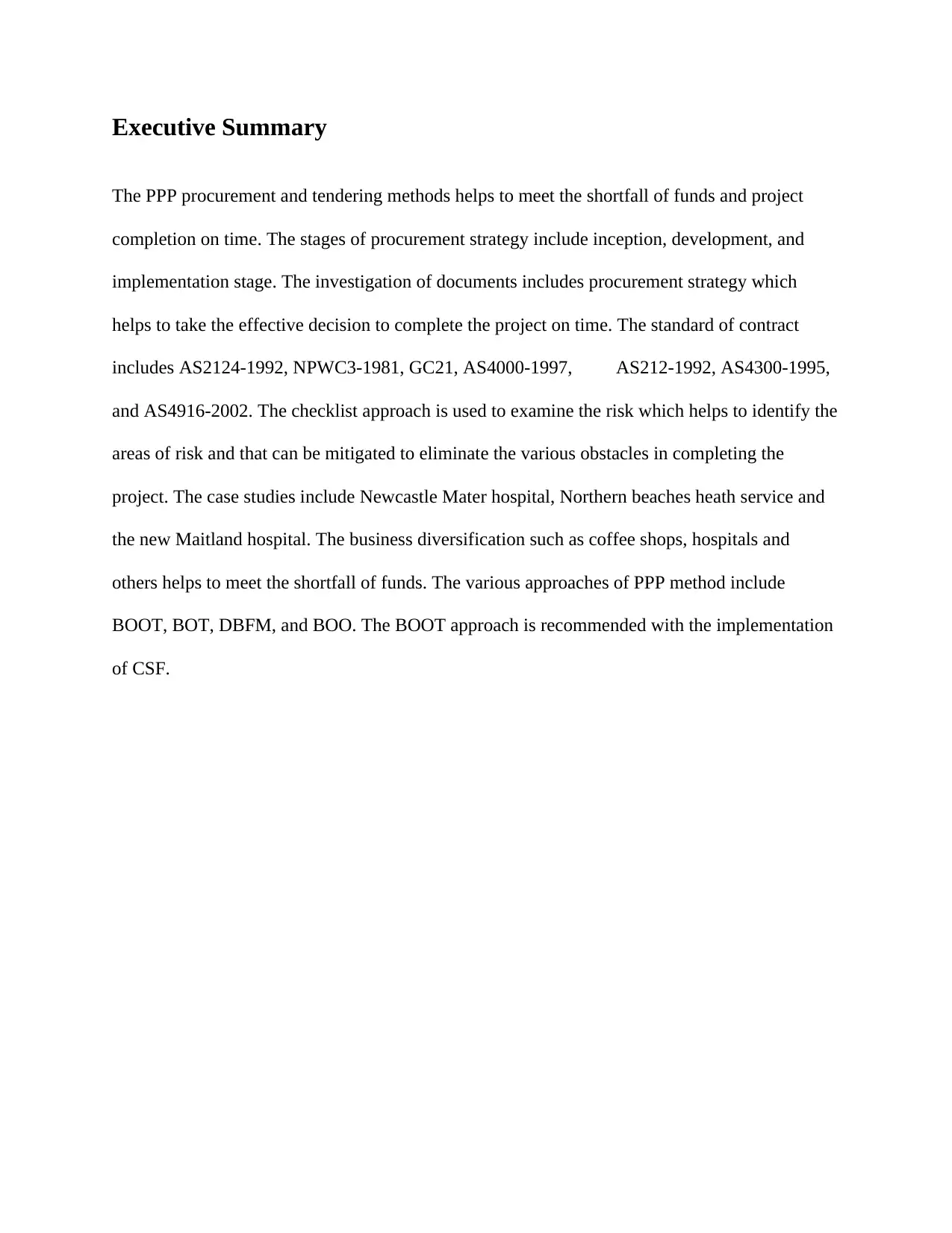
Executive Summary
The PPP procurement and tendering methods helps to meet the shortfall of funds and project
completion on time. The stages of procurement strategy include inception, development, and
implementation stage. The investigation of documents includes procurement strategy which
helps to take the effective decision to complete the project on time. The standard of contract
includes AS2124-1992, NPWC3-1981, GC21, AS4000-1997, AS212-1992, AS4300-1995,
and AS4916-2002. The checklist approach is used to examine the risk which helps to identify the
areas of risk and that can be mitigated to eliminate the various obstacles in completing the
project. The case studies include Newcastle Mater hospital, Northern beaches heath service and
the new Maitland hospital. The business diversification such as coffee shops, hospitals and
others helps to meet the shortfall of funds. The various approaches of PPP method include
BOOT, BOT, DBFM, and BOO. The BOOT approach is recommended with the implementation
of CSF.
The PPP procurement and tendering methods helps to meet the shortfall of funds and project
completion on time. The stages of procurement strategy include inception, development, and
implementation stage. The investigation of documents includes procurement strategy which
helps to take the effective decision to complete the project on time. The standard of contract
includes AS2124-1992, NPWC3-1981, GC21, AS4000-1997, AS212-1992, AS4300-1995,
and AS4916-2002. The checklist approach is used to examine the risk which helps to identify the
areas of risk and that can be mitigated to eliminate the various obstacles in completing the
project. The case studies include Newcastle Mater hospital, Northern beaches heath service and
the new Maitland hospital. The business diversification such as coffee shops, hospitals and
others helps to meet the shortfall of funds. The various approaches of PPP method include
BOOT, BOT, DBFM, and BOO. The BOOT approach is recommended with the implementation
of CSF.
⊘ This is a preview!⊘
Do you want full access?
Subscribe today to unlock all pages.

Trusted by 1+ million students worldwide
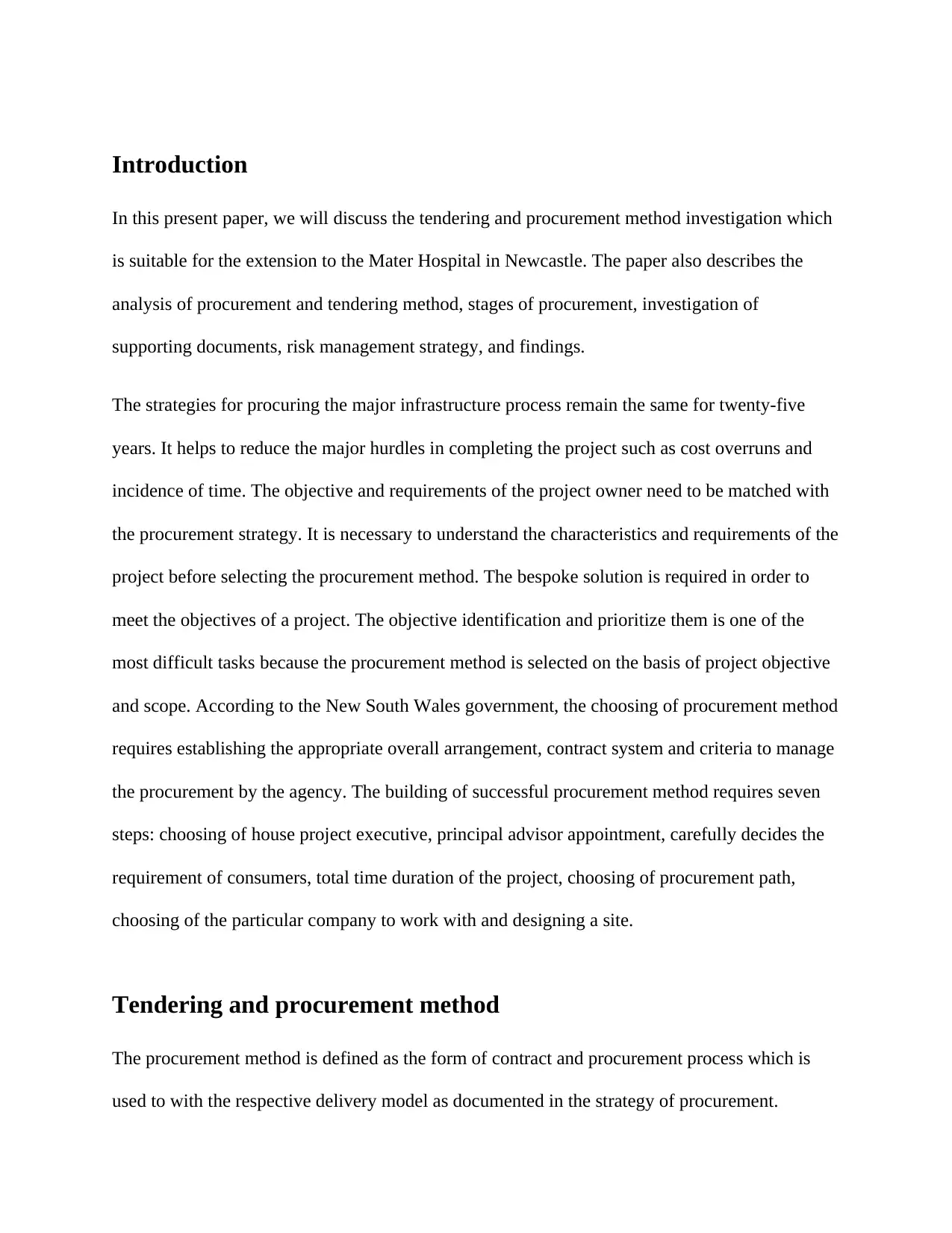
Introduction
In this present paper, we will discuss the tendering and procurement method investigation which
is suitable for the extension to the Mater Hospital in Newcastle. The paper also describes the
analysis of procurement and tendering method, stages of procurement, investigation of
supporting documents, risk management strategy, and findings.
The strategies for procuring the major infrastructure process remain the same for twenty-five
years. It helps to reduce the major hurdles in completing the project such as cost overruns and
incidence of time. The objective and requirements of the project owner need to be matched with
the procurement strategy. It is necessary to understand the characteristics and requirements of the
project before selecting the procurement method. The bespoke solution is required in order to
meet the objectives of a project. The objective identification and prioritize them is one of the
most difficult tasks because the procurement method is selected on the basis of project objective
and scope. According to the New South Wales government, the choosing of procurement method
requires establishing the appropriate overall arrangement, contract system and criteria to manage
the procurement by the agency. The building of successful procurement method requires seven
steps: choosing of house project executive, principal advisor appointment, carefully decides the
requirement of consumers, total time duration of the project, choosing of procurement path,
choosing of the particular company to work with and designing a site.
Tendering and procurement method
The procurement method is defined as the form of contract and procurement process which is
used to with the respective delivery model as documented in the strategy of procurement.
In this present paper, we will discuss the tendering and procurement method investigation which
is suitable for the extension to the Mater Hospital in Newcastle. The paper also describes the
analysis of procurement and tendering method, stages of procurement, investigation of
supporting documents, risk management strategy, and findings.
The strategies for procuring the major infrastructure process remain the same for twenty-five
years. It helps to reduce the major hurdles in completing the project such as cost overruns and
incidence of time. The objective and requirements of the project owner need to be matched with
the procurement strategy. It is necessary to understand the characteristics and requirements of the
project before selecting the procurement method. The bespoke solution is required in order to
meet the objectives of a project. The objective identification and prioritize them is one of the
most difficult tasks because the procurement method is selected on the basis of project objective
and scope. According to the New South Wales government, the choosing of procurement method
requires establishing the appropriate overall arrangement, contract system and criteria to manage
the procurement by the agency. The building of successful procurement method requires seven
steps: choosing of house project executive, principal advisor appointment, carefully decides the
requirement of consumers, total time duration of the project, choosing of procurement path,
choosing of the particular company to work with and designing a site.
Tendering and procurement method
The procurement method is defined as the form of contract and procurement process which is
used to with the respective delivery model as documented in the strategy of procurement.
Paraphrase This Document
Need a fresh take? Get an instant paraphrase of this document with our AI Paraphraser
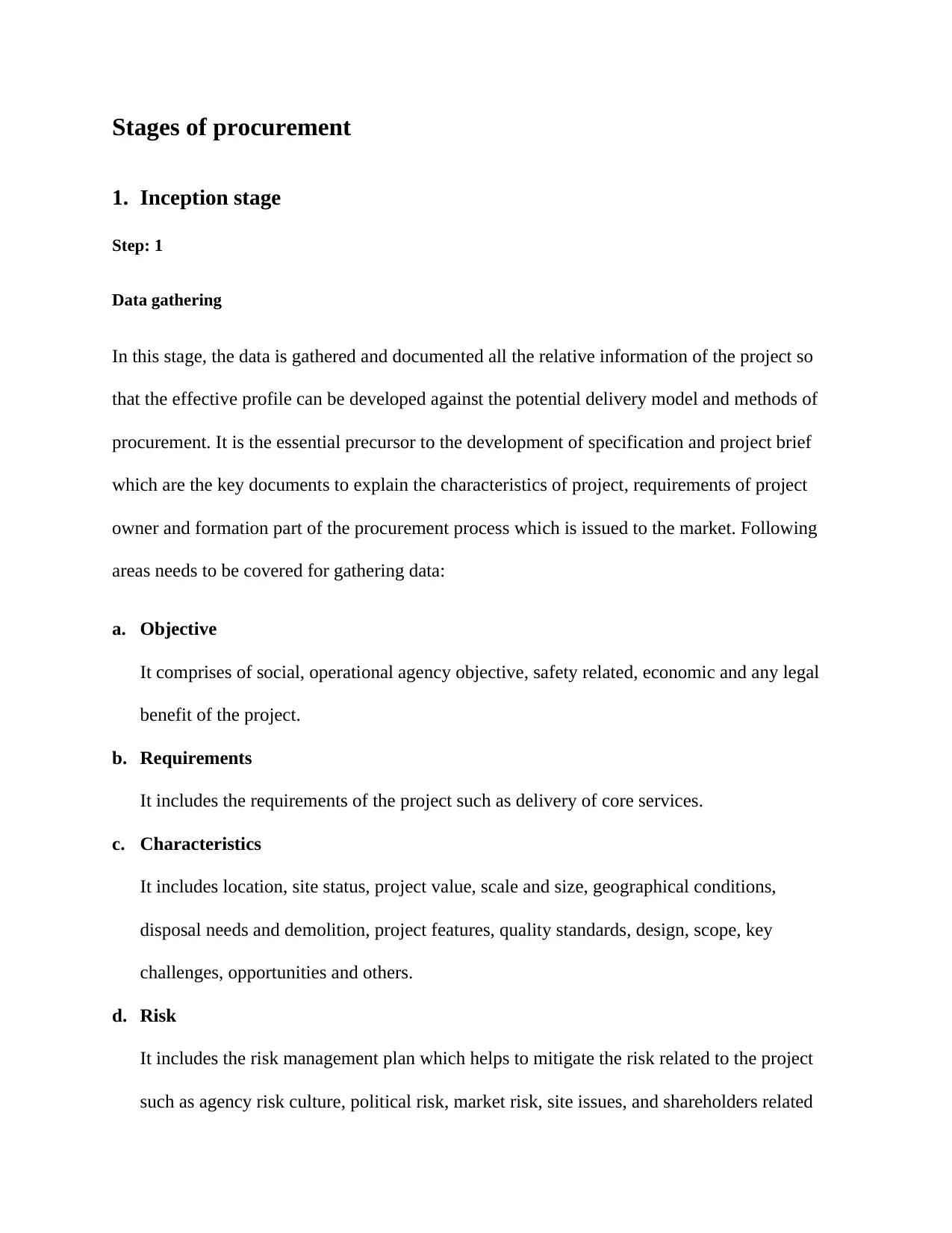
Stages of procurement
1. Inception stage
Step: 1
Data gathering
In this stage, the data is gathered and documented all the relative information of the project so
that the effective profile can be developed against the potential delivery model and methods of
procurement. It is the essential precursor to the development of specification and project brief
which are the key documents to explain the characteristics of project, requirements of project
owner and formation part of the procurement process which is issued to the market. Following
areas needs to be covered for gathering data:
a. Objective
It comprises of social, operational agency objective, safety related, economic and any legal
benefit of the project.
b. Requirements
It includes the requirements of the project such as delivery of core services.
c. Characteristics
It includes location, site status, project value, scale and size, geographical conditions,
disposal needs and demolition, project features, quality standards, design, scope, key
challenges, opportunities and others.
d. Risk
It includes the risk management plan which helps to mitigate the risk related to the project
such as agency risk culture, political risk, market risk, site issues, and shareholders related
1. Inception stage
Step: 1
Data gathering
In this stage, the data is gathered and documented all the relative information of the project so
that the effective profile can be developed against the potential delivery model and methods of
procurement. It is the essential precursor to the development of specification and project brief
which are the key documents to explain the characteristics of project, requirements of project
owner and formation part of the procurement process which is issued to the market. Following
areas needs to be covered for gathering data:
a. Objective
It comprises of social, operational agency objective, safety related, economic and any legal
benefit of the project.
b. Requirements
It includes the requirements of the project such as delivery of core services.
c. Characteristics
It includes location, site status, project value, scale and size, geographical conditions,
disposal needs and demolition, project features, quality standards, design, scope, key
challenges, opportunities and others.
d. Risk
It includes the risk management plan which helps to mitigate the risk related to the project
such as agency risk culture, political risk, market risk, site issues, and shareholders related
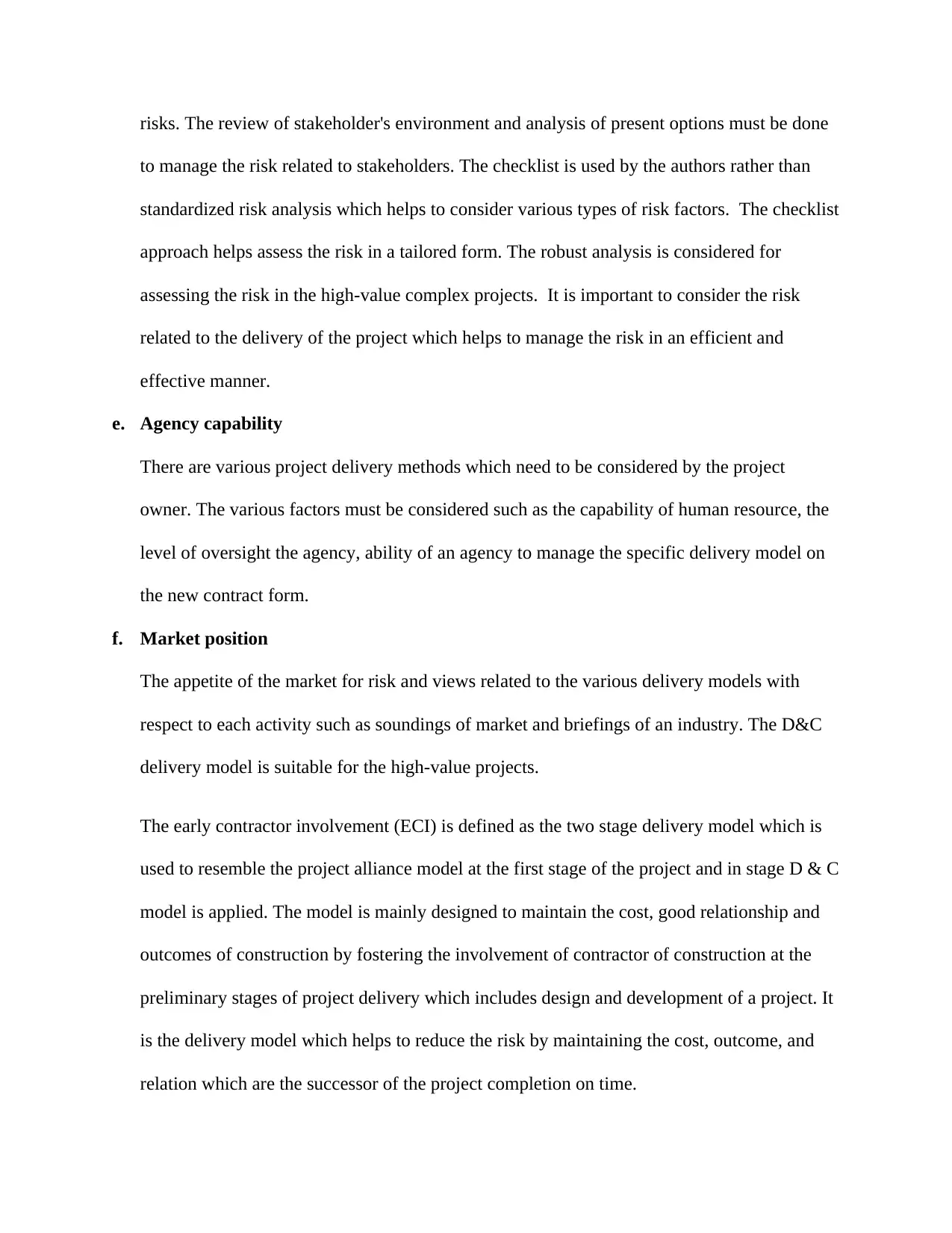
risks. The review of stakeholder's environment and analysis of present options must be done
to manage the risk related to stakeholders. The checklist is used by the authors rather than
standardized risk analysis which helps to consider various types of risk factors. The checklist
approach helps assess the risk in a tailored form. The robust analysis is considered for
assessing the risk in the high-value complex projects. It is important to consider the risk
related to the delivery of the project which helps to manage the risk in an efficient and
effective manner.
e. Agency capability
There are various project delivery methods which need to be considered by the project
owner. The various factors must be considered such as the capability of human resource, the
level of oversight the agency, ability of an agency to manage the specific delivery model on
the new contract form.
f. Market position
The appetite of the market for risk and views related to the various delivery models with
respect to each activity such as soundings of market and briefings of an industry. The D&C
delivery model is suitable for the high-value projects.
The early contractor involvement (ECI) is defined as the two stage delivery model which is
used to resemble the project alliance model at the first stage of the project and in stage D & C
model is applied. The model is mainly designed to maintain the cost, good relationship and
outcomes of construction by fostering the involvement of contractor of construction at the
preliminary stages of project delivery which includes design and development of a project. It
is the delivery model which helps to reduce the risk by maintaining the cost, outcome, and
relation which are the successor of the project completion on time.
to manage the risk related to stakeholders. The checklist is used by the authors rather than
standardized risk analysis which helps to consider various types of risk factors. The checklist
approach helps assess the risk in a tailored form. The robust analysis is considered for
assessing the risk in the high-value complex projects. It is important to consider the risk
related to the delivery of the project which helps to manage the risk in an efficient and
effective manner.
e. Agency capability
There are various project delivery methods which need to be considered by the project
owner. The various factors must be considered such as the capability of human resource, the
level of oversight the agency, ability of an agency to manage the specific delivery model on
the new contract form.
f. Market position
The appetite of the market for risk and views related to the various delivery models with
respect to each activity such as soundings of market and briefings of an industry. The D&C
delivery model is suitable for the high-value projects.
The early contractor involvement (ECI) is defined as the two stage delivery model which is
used to resemble the project alliance model at the first stage of the project and in stage D & C
model is applied. The model is mainly designed to maintain the cost, good relationship and
outcomes of construction by fostering the involvement of contractor of construction at the
preliminary stages of project delivery which includes design and development of a project. It
is the delivery model which helps to reduce the risk by maintaining the cost, outcome, and
relation which are the successor of the project completion on time.
⊘ This is a preview!⊘
Do you want full access?
Subscribe today to unlock all pages.

Trusted by 1+ million students worldwide
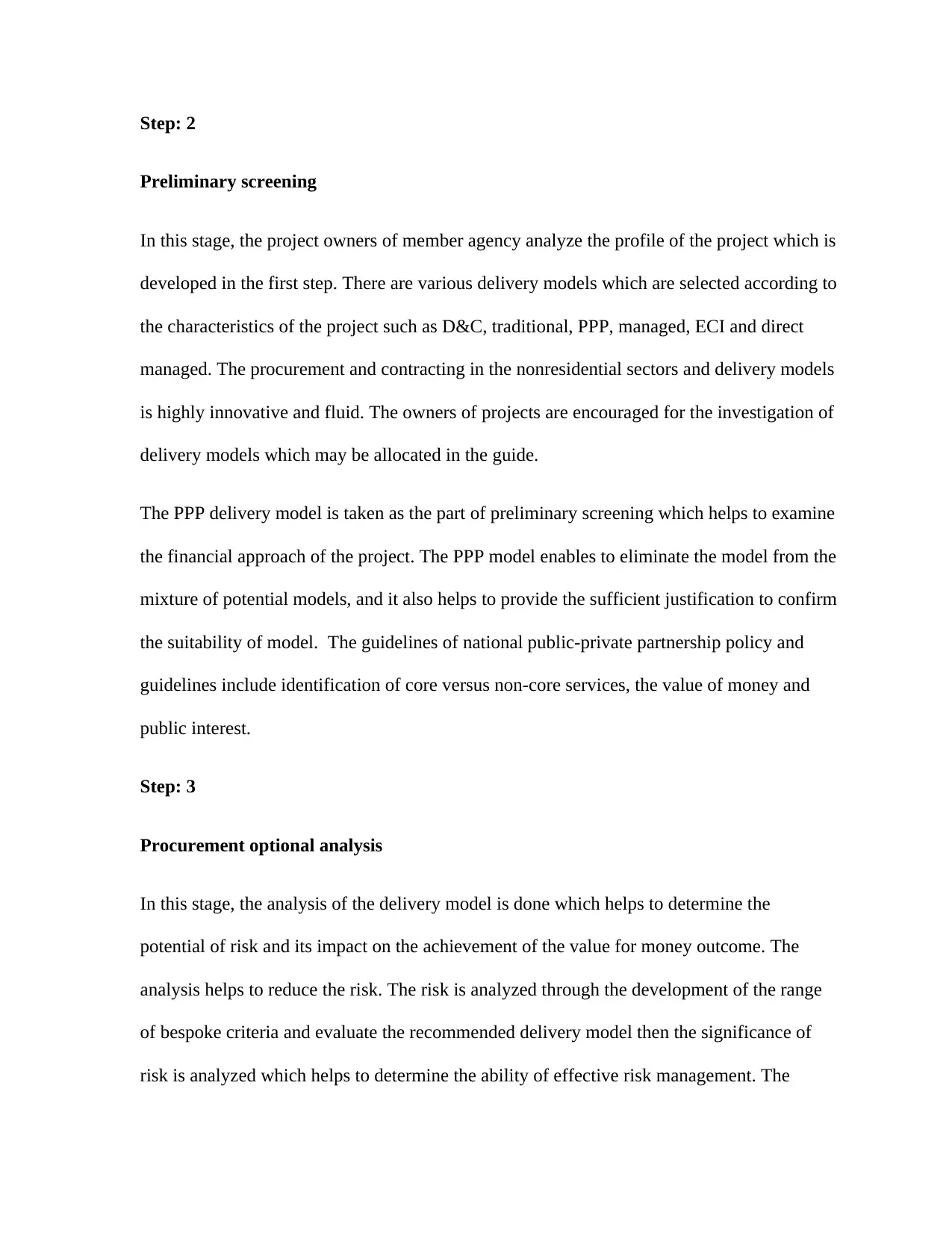
Step: 2
Preliminary screening
In this stage, the project owners of member agency analyze the profile of the project which is
developed in the first step. There are various delivery models which are selected according to
the characteristics of the project such as D&C, traditional, PPP, managed, ECI and direct
managed. The procurement and contracting in the nonresidential sectors and delivery models
is highly innovative and fluid. The owners of projects are encouraged for the investigation of
delivery models which may be allocated in the guide.
The PPP delivery model is taken as the part of preliminary screening which helps to examine
the financial approach of the project. The PPP model enables to eliminate the model from the
mixture of potential models, and it also helps to provide the sufficient justification to confirm
the suitability of model. The guidelines of national public-private partnership policy and
guidelines include identification of core versus non-core services, the value of money and
public interest.
Step: 3
Procurement optional analysis
In this stage, the analysis of the delivery model is done which helps to determine the
potential of risk and its impact on the achievement of the value for money outcome. The
analysis helps to reduce the risk. The risk is analyzed through the development of the range
of bespoke criteria and evaluate the recommended delivery model then the significance of
risk is analyzed which helps to determine the ability of effective risk management. The
Preliminary screening
In this stage, the project owners of member agency analyze the profile of the project which is
developed in the first step. There are various delivery models which are selected according to
the characteristics of the project such as D&C, traditional, PPP, managed, ECI and direct
managed. The procurement and contracting in the nonresidential sectors and delivery models
is highly innovative and fluid. The owners of projects are encouraged for the investigation of
delivery models which may be allocated in the guide.
The PPP delivery model is taken as the part of preliminary screening which helps to examine
the financial approach of the project. The PPP model enables to eliminate the model from the
mixture of potential models, and it also helps to provide the sufficient justification to confirm
the suitability of model. The guidelines of national public-private partnership policy and
guidelines include identification of core versus non-core services, the value of money and
public interest.
Step: 3
Procurement optional analysis
In this stage, the analysis of the delivery model is done which helps to determine the
potential of risk and its impact on the achievement of the value for money outcome. The
analysis helps to reduce the risk. The risk is analyzed through the development of the range
of bespoke criteria and evaluate the recommended delivery model then the significance of
risk is analyzed which helps to determine the ability of effective risk management. The
Paraphrase This Document
Need a fresh take? Get an instant paraphrase of this document with our AI Paraphraser
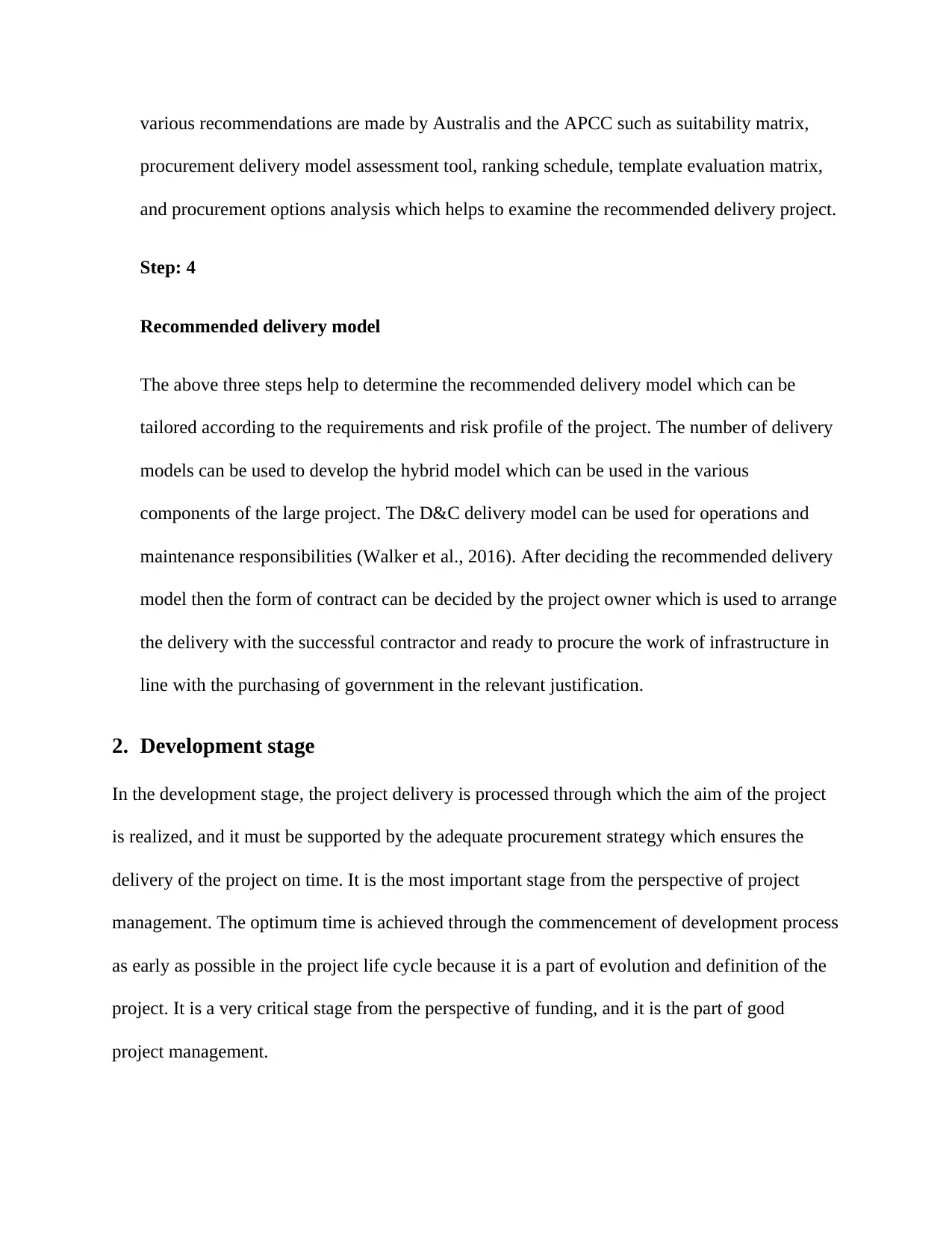
various recommendations are made by Australis and the APCC such as suitability matrix,
procurement delivery model assessment tool, ranking schedule, template evaluation matrix,
and procurement options analysis which helps to examine the recommended delivery project.
Step: 4
Recommended delivery model
The above three steps help to determine the recommended delivery model which can be
tailored according to the requirements and risk profile of the project. The number of delivery
models can be used to develop the hybrid model which can be used in the various
components of the large project. The D&C delivery model can be used for operations and
maintenance responsibilities (Walker et al., 2016). After deciding the recommended delivery
model then the form of contract can be decided by the project owner which is used to arrange
the delivery with the successful contractor and ready to procure the work of infrastructure in
line with the purchasing of government in the relevant justification.
2. Development stage
In the development stage, the project delivery is processed through which the aim of the project
is realized, and it must be supported by the adequate procurement strategy which ensures the
delivery of the project on time. It is the most important stage from the perspective of project
management. The optimum time is achieved through the commencement of development process
as early as possible in the project life cycle because it is a part of evolution and definition of the
project. It is a very critical stage from the perspective of funding, and it is the part of good
project management.
procurement delivery model assessment tool, ranking schedule, template evaluation matrix,
and procurement options analysis which helps to examine the recommended delivery project.
Step: 4
Recommended delivery model
The above three steps help to determine the recommended delivery model which can be
tailored according to the requirements and risk profile of the project. The number of delivery
models can be used to develop the hybrid model which can be used in the various
components of the large project. The D&C delivery model can be used for operations and
maintenance responsibilities (Walker et al., 2016). After deciding the recommended delivery
model then the form of contract can be decided by the project owner which is used to arrange
the delivery with the successful contractor and ready to procure the work of infrastructure in
line with the purchasing of government in the relevant justification.
2. Development stage
In the development stage, the project delivery is processed through which the aim of the project
is realized, and it must be supported by the adequate procurement strategy which ensures the
delivery of the project on time. It is the most important stage from the perspective of project
management. The optimum time is achieved through the commencement of development process
as early as possible in the project life cycle because it is a part of evolution and definition of the
project. It is a very critical stage from the perspective of funding, and it is the part of good
project management.
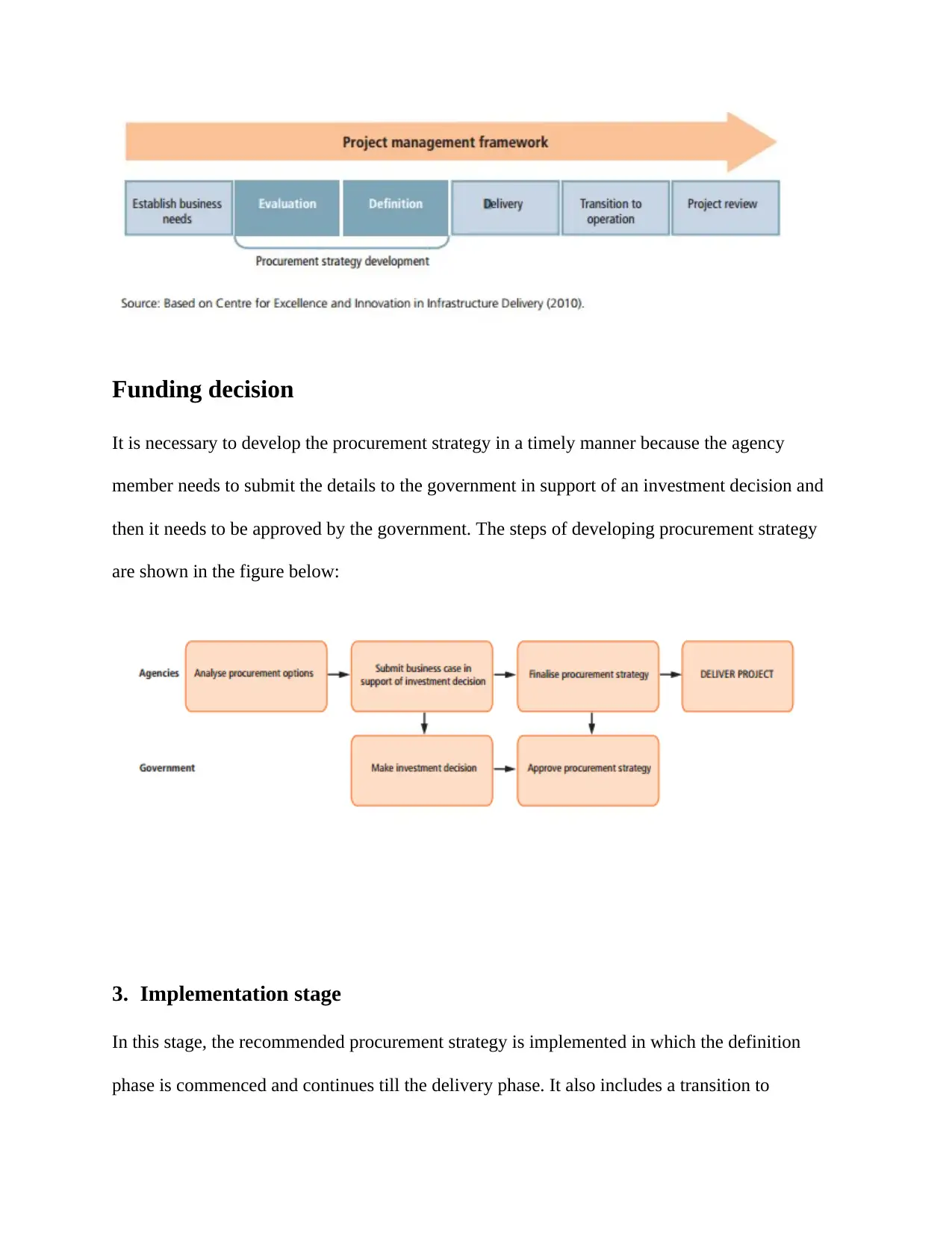
Funding decision
It is necessary to develop the procurement strategy in a timely manner because the agency
member needs to submit the details to the government in support of an investment decision and
then it needs to be approved by the government. The steps of developing procurement strategy
are shown in the figure below:
3. Implementation stage
In this stage, the recommended procurement strategy is implemented in which the definition
phase is commenced and continues till the delivery phase. It also includes a transition to
It is necessary to develop the procurement strategy in a timely manner because the agency
member needs to submit the details to the government in support of an investment decision and
then it needs to be approved by the government. The steps of developing procurement strategy
are shown in the figure below:
3. Implementation stage
In this stage, the recommended procurement strategy is implemented in which the definition
phase is commenced and continues till the delivery phase. It also includes a transition to
⊘ This is a preview!⊘
Do you want full access?
Subscribe today to unlock all pages.

Trusted by 1+ million students worldwide
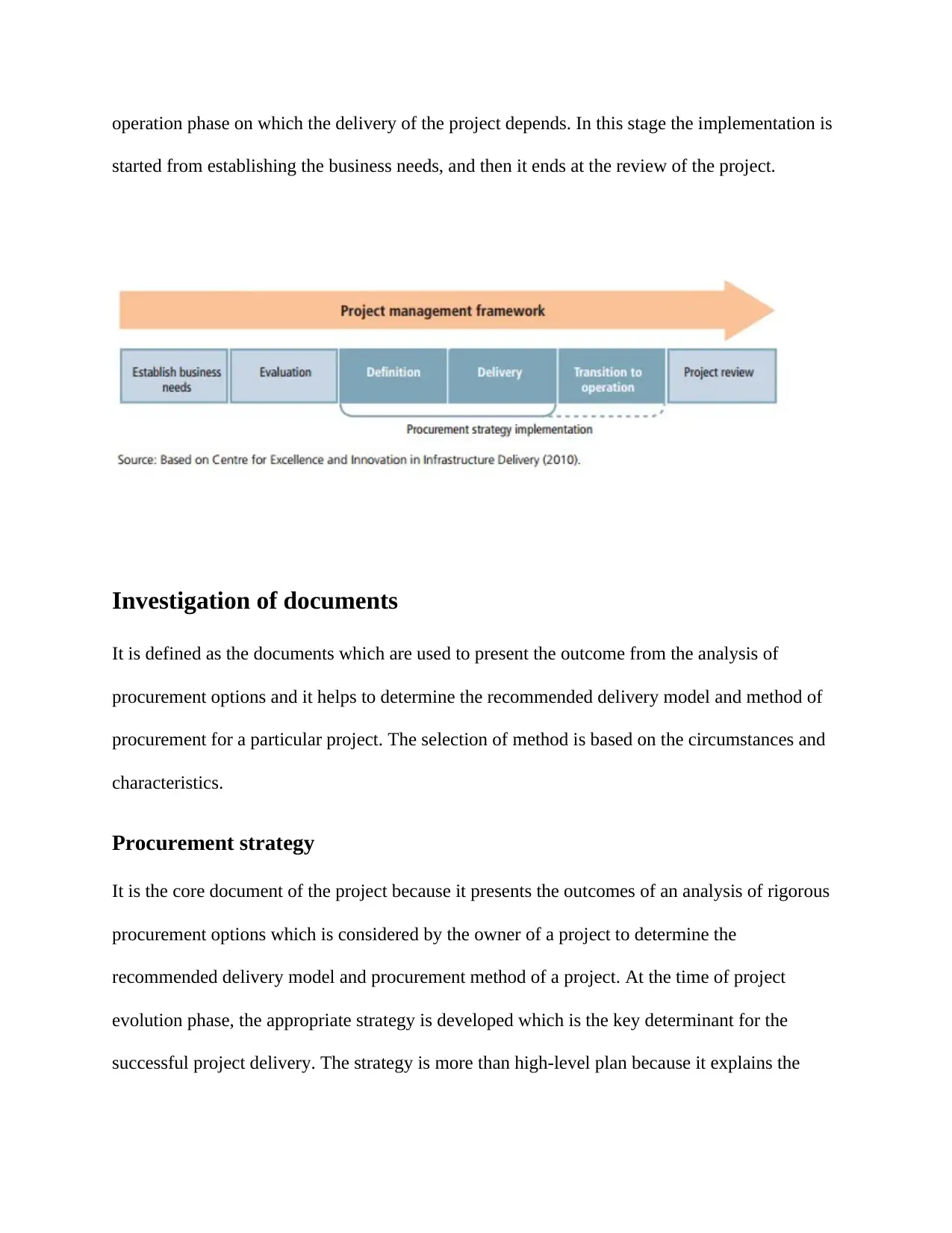
operation phase on which the delivery of the project depends. In this stage the implementation is
started from establishing the business needs, and then it ends at the review of the project.
Investigation of documents
It is defined as the documents which are used to present the outcome from the analysis of
procurement options and it helps to determine the recommended delivery model and method of
procurement for a particular project. The selection of method is based on the circumstances and
characteristics.
Procurement strategy
It is the core document of the project because it presents the outcomes of an analysis of rigorous
procurement options which is considered by the owner of a project to determine the
recommended delivery model and procurement method of a project. At the time of project
evolution phase, the appropriate strategy is developed which is the key determinant for the
successful project delivery. The strategy is more than high-level plan because it explains the
started from establishing the business needs, and then it ends at the review of the project.
Investigation of documents
It is defined as the documents which are used to present the outcome from the analysis of
procurement options and it helps to determine the recommended delivery model and method of
procurement for a particular project. The selection of method is based on the circumstances and
characteristics.
Procurement strategy
It is the core document of the project because it presents the outcomes of an analysis of rigorous
procurement options which is considered by the owner of a project to determine the
recommended delivery model and procurement method of a project. At the time of project
evolution phase, the appropriate strategy is developed which is the key determinant for the
successful project delivery. The strategy is more than high-level plan because it explains the
Paraphrase This Document
Need a fresh take? Get an instant paraphrase of this document with our AI Paraphraser
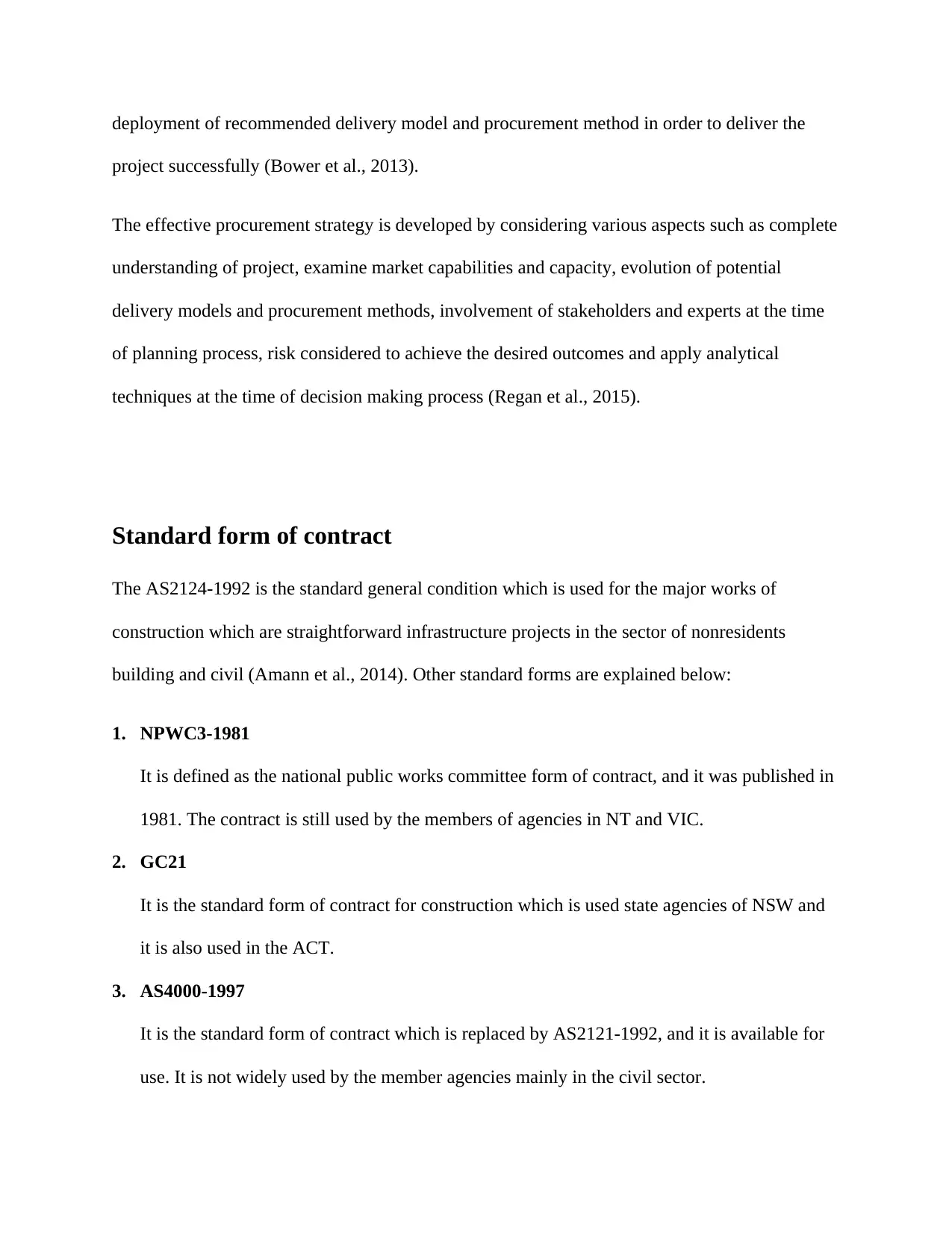
deployment of recommended delivery model and procurement method in order to deliver the
project successfully (Bower et al., 2013).
The effective procurement strategy is developed by considering various aspects such as complete
understanding of project, examine market capabilities and capacity, evolution of potential
delivery models and procurement methods, involvement of stakeholders and experts at the time
of planning process, risk considered to achieve the desired outcomes and apply analytical
techniques at the time of decision making process (Regan et al., 2015).
Standard form of contract
The AS2124-1992 is the standard general condition which is used for the major works of
construction which are straightforward infrastructure projects in the sector of nonresidents
building and civil (Amann et al., 2014). Other standard forms are explained below:
1. NPWC3-1981
It is defined as the national public works committee form of contract, and it was published in
1981. The contract is still used by the members of agencies in NT and VIC.
2. GC21
It is the standard form of contract for construction which is used state agencies of NSW and
it is also used in the ACT.
3. AS4000-1997
It is the standard form of contract which is replaced by AS2121-1992, and it is available for
use. It is not widely used by the member agencies mainly in the civil sector.
project successfully (Bower et al., 2013).
The effective procurement strategy is developed by considering various aspects such as complete
understanding of project, examine market capabilities and capacity, evolution of potential
delivery models and procurement methods, involvement of stakeholders and experts at the time
of planning process, risk considered to achieve the desired outcomes and apply analytical
techniques at the time of decision making process (Regan et al., 2015).
Standard form of contract
The AS2124-1992 is the standard general condition which is used for the major works of
construction which are straightforward infrastructure projects in the sector of nonresidents
building and civil (Amann et al., 2014). Other standard forms are explained below:
1. NPWC3-1981
It is defined as the national public works committee form of contract, and it was published in
1981. The contract is still used by the members of agencies in NT and VIC.
2. GC21
It is the standard form of contract for construction which is used state agencies of NSW and
it is also used in the ACT.
3. AS4000-1997
It is the standard form of contract which is replaced by AS2121-1992, and it is available for
use. It is not widely used by the member agencies mainly in the civil sector.

4. AS212-1992
It is presently being revised, and it will be available for APCC member agencies and
Austroads after standard Australia process completion. In the updating of AS212-1992, the
APCC is directly involved in this process.
5. AS4300-1995
It is a form of contract which is used by the D&C projects for delivering the project under
D&C delivery model. The agencies in NSW, SA, and the ACT also use the GC21 form of
contract and the VIC, and NT use an NPWC3-1981 form of contract (Coggins et al., 2016).
6. AS4916-2002
The modified version of AS4916-2002 is used in QLD and the WA use modified version of
AS2124-1992. The amended department of health construction management contracts is used
by the VIC agencies (Morledge et al., 2013).
Risk management strategy
The checklist approach is used to assess the risk which helps to examine the risk in a customized
manner. The aspects of risk are identified through the prioritization of key objectives of the
project, and then the management of risk process is established with the successful project
outcomes. The high degree of risk is confronted by the client because of unique bespoke nature.
There is various type of risk involved such as project completion on time, cost overruns,
financial risk and others which directly impacts on the sore business of the client. The
procurement strategy must be developed in order to balance the risk against the objective of the
project. The weighted list of prioritizing must be developed which helps to consider high
weighted risk in the overall procurement system (Teo et al., 2013).
It is presently being revised, and it will be available for APCC member agencies and
Austroads after standard Australia process completion. In the updating of AS212-1992, the
APCC is directly involved in this process.
5. AS4300-1995
It is a form of contract which is used by the D&C projects for delivering the project under
D&C delivery model. The agencies in NSW, SA, and the ACT also use the GC21 form of
contract and the VIC, and NT use an NPWC3-1981 form of contract (Coggins et al., 2016).
6. AS4916-2002
The modified version of AS4916-2002 is used in QLD and the WA use modified version of
AS2124-1992. The amended department of health construction management contracts is used
by the VIC agencies (Morledge et al., 2013).
Risk management strategy
The checklist approach is used to assess the risk which helps to examine the risk in a customized
manner. The aspects of risk are identified through the prioritization of key objectives of the
project, and then the management of risk process is established with the successful project
outcomes. The high degree of risk is confronted by the client because of unique bespoke nature.
There is various type of risk involved such as project completion on time, cost overruns,
financial risk and others which directly impacts on the sore business of the client. The
procurement strategy must be developed in order to balance the risk against the objective of the
project. The weighted list of prioritizing must be developed which helps to consider high
weighted risk in the overall procurement system (Teo et al., 2013).
⊘ This is a preview!⊘
Do you want full access?
Subscribe today to unlock all pages.

Trusted by 1+ million students worldwide
1 out of 23
Related Documents
Your All-in-One AI-Powered Toolkit for Academic Success.
+13062052269
info@desklib.com
Available 24*7 on WhatsApp / Email
![[object Object]](/_next/static/media/star-bottom.7253800d.svg)
Unlock your academic potential
Copyright © 2020–2025 A2Z Services. All Rights Reserved. Developed and managed by ZUCOL.





